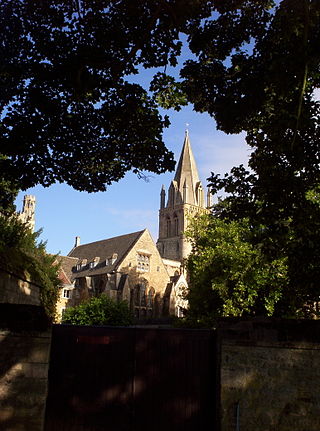Related Research Articles

Bolton Abbey Estate in Wharfedale, North Yorkshire, England, takes its name from a 12th-century Augustinian monastery of canons regular, now known as Bolton Priory. The priory, which was closed in the 1539 Dissolution of the Monasteries ordered by King Henry VIII, is in the Yorkshire Dales, which lies next to the village of Bolton Abbey.

Wenlock Priory, or St Milburga's Priory, is a ruined 12th-century monastery, located in Much Wenlock, Shropshire, at grid reference SJ625001. Roger de Montgomery re-founded the Priory as a Cluniac house between 1079 and 1082, on the site of an earlier 7th-century monastery. In 1101 bones, believed to be those of Saint Milburga, were discovered beneath the floor of the old church. The relics were ceremoniously translated to the main monastery church.

Canonsleigh Abbey was an Augustinian priory in the parish of Burlescombe, Devon.

St Frideswide's Priory was established as a priory of Augustinian canons regular in Oxford in 1122. The priory was established by Gwymund, chaplain to Henry I of England. Among its most illustrious priors were the writers Robert of Cricklade and Philip of Oxford.

Aldcliffe is a hamlet, and former township and civil parish, now in the parish of Aldcliffe-with-Stodday, south-west of Lancaster, in the Lancaster district, in the county of Lancashire, England. The hamlet is located on the east bank of the River Lune, and is one and a half miles south west of the Lancaster city centre.

Hatfield Broad Oak Priory, or Hatfield Regis Priory, is a former Benedictine priory in Hatfield Broad Oak, Essex, England. Founded by 1139, it was dissolved in 1536 as part of Henry VIII's dissolution of the monasteries.
The Priory of St Mary, Huntingdon was an Augustinian Priory in Huntingdonshire, England.
Beckford Priory was a medieval house of Augustinian Canons, historically within Gloucestershire, presently in Worcestershire, England. It was founded in Beckford in or shortly after 1128 as a dependency of the priory of Sainte-Barbe-en-Auge in Normandy. It was taken into the King's hand in 1414 as an alien priory and granted in 1462 to Eton College, but was re-granted by Edward IV to the collegiate church of Fotheringay. In 1547 the college was suppressed, and the site passed into lay ownership. A new house, known as Beckford Hall, was built in the 17th century on the former premises. The house was used in the 20th century as a Roman Catholic college.
Alnesbourne Priory, also known as Alnesbourn Priory, was a small Augustinian monastic house in the English county of Suffolk. It was located near Nacton to the south-east of Ipswich near to the River Orwell and the current route of the A14.
St Peter & Paul Priory, Ipswich was an Augustinian priory in Ipswich Suffolk, England.

Rumburgh Priory was a Benedictine priory located in the village of Rumburgh in the English county of Suffolk. The priory was founded in about 1065 as a cell of St Benet's Abbey at Hulme in Norfolk. At the time of the Domesday Book in 1086 it had 12 monks. The ownership of the priory was transferred to St Mary's Abbey in York towards the end of the 12th century. The monks of Rumburgh were particularly devoted to St. Bee, whom they commemorated at Michaelmas.
Horsley Priory was a medieval, monastic house in Gloucestershire, England.

Monks Kirby Priory was a Benedictine priory established in 1077 in Monks Kirby, Warwickshire, England. The priory was suppressed in 1415 when its estates and revenues were given to the Carthusian priory of Axholme in Lincolnshire, in whose possession they continued until the Reformation. Remains of the priory form part of Monks Kirby village church today.

Upavon Priory was a small priory in Wiltshire, England.

Poulton is a village and civil parish in the English county of Gloucestershire, approximately 24 miles (39 km) to the south-east of Gloucester. It lies in the south of the Cotswolds, an Area of Outstanding Natural Beauty. In the 2001 United Kingdom census, the parish had a population of 398, increasing to 408 at the 2011 census.

St Mary the Virgin's Church is a former priory church in the village of Bromfield, Shropshire, England. It is an active Anglican parish church in the deanery of Ludlow, the archdeaconry of Ludlow, and the diocese of Hereford. Its benefice is united with those of 5 other parishes to form the Bromfield Benefice. The church is recorded in the National Heritage List for England as a designated Grade I listed building.
William Devereux was an Anglo-Norman nobleman living during the reigns of kings William I, William II, and Henry I of England. The Devereux, along with the Baskervilles and Pichards, were prominent knightly families along the Welsh marches at the beginning of the twelfth century, and linked to the Braose and Lacy lordships of the region. William Devereux's descendants would later give rise to the Devereux family of Hereford, and the Devereux Viscounts of Hereford and Earls of Essex.
Culvestan was a hundred of Shropshire, England. Formed during Anglo-Saxon England, it encompassed manors in central southern Shropshire, and was amalgamated during the reign of Henry I with the neighbouring hundred of Patton to form the Munslow hundred.

Morville Priory was a small Benedictine monastery in Shropshire, England, a cell of Shrewsbury Abbey.
References
- ↑ Open Domesday Archived 2013-11-12 at the Wayback Machine Bromfield
- ↑ "Houses of Benedictine monks: Priory of Bromfield". British History Online.
52°23′13″N2°45′48″W / 52.3869°N 2.7633°W

